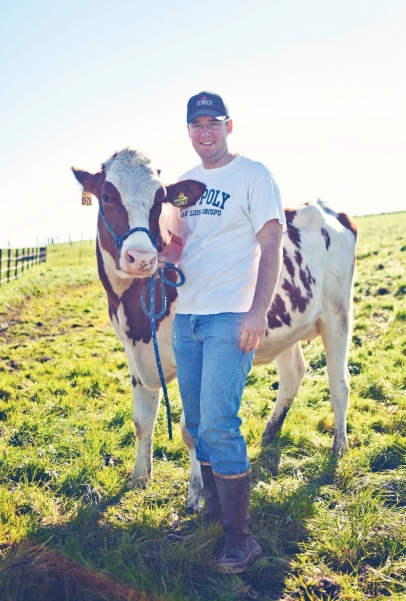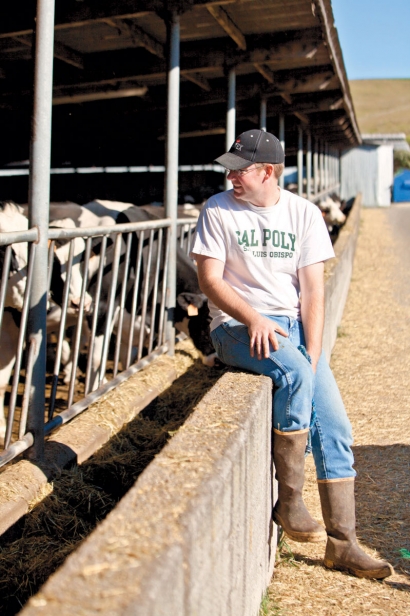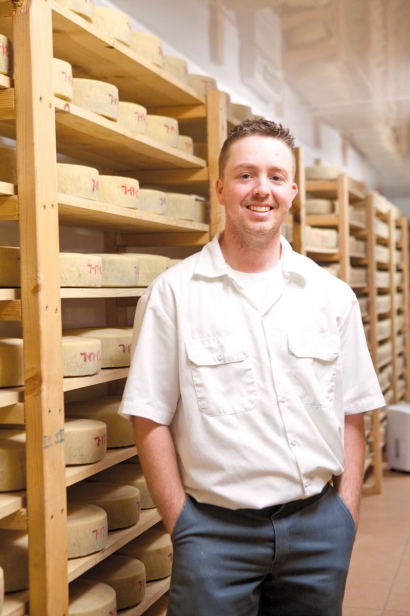Stepping Up: A New Generation at the Helm
Along the busy Highway 101 corridor of Marin and Sonoma counties, we tend to measure time in hours or hurried minutes. But driving west past the Nicasio Reservoir, across the painted bridge toward Pt. Reyes Station, and then north along Highway 1 toward Marshall, time begins to both slow and expand. I can see geographic movement in the knuckle-like wrinkles of Black Mountain, and sense the work of the tides along the shores of Tomales Bay.
This ample sense of time is fitting, as I am on my way to visit two of the older dairies in the area, looking to meet two members of the youngest generation working in this ancient industry. Specifically, I am going to meet a herdsman at Pt. Reyes Farmstead Cheese Company, and a cheesemaker at Valley Ford Cheese. In an era when employment opportunities for college graduates are often completely disconnected from the past, I am intrigued by the chosen work of these 20-somethings, and hoping to see firsthand how they build on the work of previous generations.
Pt. Reyes Farmstead
A few miles north of Pt. Reyes I turn right off of Highway 1. A sign points me uphill onto a single-lane drive promising arrival at the Robert Giacomini Dairy. Here, as I wind over the knolls, I can imagine small native settlements nestled in the nooks and hollows of the hillsides. I can envision a new wave of European immigrants, carrying their understanding of animal husbandry and cheesemaking as they survey the vast expanses of pasture here.
I crest a ridge above the bay, mesmerized by countless emerald rises, when, suddenly, I arrive at a bustling modern- day village of dairy industry: milking barns, cow paddocks, methane digester, storage silos, employee housing and a state-of-the-art farmstead building.
Farmers will often tell you that success in working the land involves adaptation over time. Ideally, as new generations step up to farm, they build on the wisdom of their parents and grandparents, and bring their own energy and innovations to the land. The problem in the United States, with a long-term market disadvantage for the small farm and the exodus of a generation of young people from agriculture, is that successful family farms age and fall out of productivity over time. According to the 2007 USDA Census of Agriculture, the average age of American farmers when the Census was taken was over 60 years old (which likely means the average age is around 65 today).
West Marin and Sonoma are no exception to this trend and, despite support from organizations like Marin Agricultural Land Trust and Marin Organic, it is easy to spot once- successful farms that now languish. The Giacomini Dairy provides a counterpoint to the trend, and an opportunity to see multiple generations at work, on the same land, adapting and thriving.
When I arrive, Jill Giacomini Basch greets me in the foyer of the gorgeous new main farmstead building and business office. She is one of the four daughters of Bob and Dean Giacomini, who purchased the property and started the dairy in 1959. Basch grew up on the ranch, then left for school, a career and life adventures, and now, along with her three sisters, has come back to the family farm. In 2000, wanting to prepare for their father’s future retirement and safeguard the dairy, the Giacomini sisters got together with their parents and made a plan. They intuited a burgeoning market for artisanal cheese and developed a business model that would build on the success of the dairy while infusing energy into the family business.
As we sit in the tasting room of The Fork, a state-of-the art kitchen and tasting room designed for public events, Basch tells me the story of their signature cheese, Pt. Reyes Farmstead Original Blue.
“We realized there was very little high-quality blue cheese on the market in the United States, and that we would be the only blue cheese in Marin. We quit our day jobs, rolled up our sleeves and hired a cheesemaker.” Now, over a decade later, Pt. Reyes Farmstead Original Blue has won many national and international awards, and the family has developed two more award-winning cheeses, a hard cheese called Toma and, most recently, an incredible Stilton-like cheese called Bay Blue, winner at the 2013 Good Food Awards.
The key to all of this, of course, is the Giacomini’s herd of around 800 Holstein and Brown Swiss cows, and their health, happiness and milk production. Basch is visibly excited to introduce me to Brian Waymire, the young man her father hired as herdsman two and a half years ago.
“My father called down to Cal Poly and spoke to the head of the [dairy science] program there, who said he had someone for him, a graduating student he could definitely recommend.”
I have heard that Waymire has a confidence and know-how well beyond his years, so I came to see for myself how this 25-year-old manages the herd behind the famous Pt. Reyes Farmstead cheeses. Waymire appears, and, good-natured and helpful as he is, I can see that he is a man in the middle of a busy day. There is, in fact, a maturity in the way he carries himself that can only be born of experience, of having been tried and tested. His mind and eye are attentive to the details of the ranch, and, as we tour the dairy, I can see why it would be difficult to take a mental break just to chat.
As head herdsman, Waymire oversees the herd from before birth through the prime milking and calving years, to retirement. He also manages the pastures, the supplemental feed and the silage. He works with a nutritionist, a veterinarian and the creamery staff, including Kuba Emmerling, Pt. Reyes Farmstead’s cheesemaker.
“I grew up on a farm in Hanford, in Central California,” Waymire tells me when I ask him what kind of childhood might have prepared him for so much responsibility. “We grew cotton, pistachios, walnuts and wheat. And my grandfather, uncles and brother-in-law all have dairies.” We make our way up to Waymire’s office, where a large window provides a view down into the milking parlor. Two employees bring the cows through a sanitizing bath into the barn, and hook them up to milking machines, tending them constantly.
“We milk two times a day, at 2am and 2pm,” says Waymire. “We milk 340 cows and get approximately nine gallons of milk per day, per cow; 40 years ago, it took 40% more animals to get the same yield.” According to Waymire, the main improvements in herding practices are in cow comfort (things like fresh, dry bedding and proper foot trimming), the ratios of various feed and supplements, and genetics (breeding for high milk produc- tion and high butterfat). Next we walk to the “maternity ward,” where we round the corner and peer into a stable where a beautiful mama stands guard over her brand new still-wet calf.
“This one was born about an hour and a half ago,” Waymire tells me. He goes on to describe the life of a fertile Giacomini cow. “We bring them in for a 60-day dry period for rest, vaccines and a special diet with extra vitamins and minerals.” An important part of Waymire’s job is working consistently with the nutritionist to analyze the milk components and make diet adjustments, all the while considering the prices of available feed.
The next barn is full of massive stores of feed. The pastoral land provides 30% of the herd’s diet year-round, and is the primary influence on the milk’s flavor, but supplemental feeds also plays a critical role in cow health and milk produc- tion. When Waymire tells me that each cow consumes 120 pounds of feed and 80 to 90 gallons of water a day, I begin to understand the scale of the daily process. Even as I take notes, it is daunting to keep track of the variables, and yet he seems at ease about the entire production.
“I’ve worked on farms. I’ve had internships at different dairies. I was the herdsman at Cal Poly. I’ve learned something from everyone along the way.” One of the first things Waymire did as herdsman at the Giacomini Dairy was to purchase an ultra-sound, a tool he had learned to use in his genetics and reproduction classes at Cal Poly.
I ask if there were any initial hurdles when he first took the position and he smiles. “Yes,” he says. “There is a lot of pasture involved here. It is as much about pasture management as anything—when to put out, replanting. I get help. I learn a lot from friends in the area. I had a lot to learn.”
Unlike so many young people, Waymire does not seem to be in a rush. He appears to have a comfort level with what he does not know, the idea that he will be learning along the way, which may be exactly why he is where he is today.
Valley Ford Cheese
About 20 miles further north, just past the small town of Valley Ford on the hills above Estero Americano, sits an idyllic white cluster of farm buildings. This is the Mountain View Jerseys dairy and Valley Ford Cheese Company, where I meet Joe Moreda, Waymire’s former “little brother” in their fraternity at Cal Poly and a member of the fifth generation in the Grossi and Bianchi families to work in the dairy business. Moreda’s great-great-grandparents, Swiss-Italian immigrants Dominico and Teresa Grossi, started a dairy outside Novato in the late 1800s. His Bianchi great-great- grandparents emigrated from Northern Italy in the early 1900s and purchased the property outside Valley Ford that is now Mountain View Jerseys Dairy and where Joe and his mother, Karen Bianchi-Moreda, have established Valley Ford Cheese using the dairy’s rich Jersey cow milk.
Like Waymire, Moreda is very courteous when he greets me at the door of his kitchen, but as he peels off his gloves and hair covering I can’t help but feel a bit remiss about interrupting a busy workday. “Yes, most of the time I work six days a week from 5 to 5,” Moreda confirms. “Long hours, but I have to say, time flies by. I am always so busy thinking about what needs to be done next, getting to the next step.”
As I look around his cheesemaking headquarters I am struck by how orderly and clean the entire facility is, especially the floor, which shines like a porcelain dinner plate. Having teenagers not much younger than Moreda in my own home, I can’t help but ask where he learned the tidiness habit.
He looks at me as if the answer is obvious: “This place has to be clean. Not a single curd on the floor. For making cheese, it has to be a completely sanitary environment.” He then smiles and admits, “But I don’t keep my house quite this clean.”
Like Waymire, Moreda had opportunity to glean trade secrets and best practices through classes in dairy science and technology, a job at the Cal Poly campus creamery and various internships, including a summer at Leprino Foods in Grand Rapids, Michigan, producing mozzarella. I admire the stainless steel lines that carry 250 gallons of milk a day up to an enormous vat, where Moreda raises the temperature and adds the culture and rennet. “You should have seen this room when my mom started this in 2008,” he tells me. “She had a very small square vat in here that she would stir by hand.”
The mother-son team has perfected two hard cheeses: Estero Gold, an Italian farmstead Asiago-type cheese developed in honor of the Bianchi-Moreda’s Swiss-Italian ancestry; and an “old-style Fontina” called Highway 1. Both cheeses have had tremendous market and critical success, including double-gold medals at the Sonoma County Harvest Fair and Best of Show for Estero Gold in 2011.
With this rapid success, they have had to scramble to expand their facility and equipment. Joe shows me three recently added aging rooms and points out that they are already using most of the shelf space. “My pride is taking care of these cheeses,” he says, flipping one of the rounds that have been marked with their date in what he calls the “old-fashioned” way, using a food-grade dye.
Back in the first room, he picks up a large two-handled knife and says, “This we do need to upgrade! We are currently processing thousands of orders and still hand-cutting our cheese. It’s nuts!”
Joe’s younger brother, Jim, is currently finishing his dairy science degree at Cal Poly, so he, too, will likely join in the family trade. “My brother and I have big plans for the future. Multiple organic dairy products and national sales,” Moreda says as he pulls a batch of Highway 1 cheese from the press. “But for now, I’m doing this work.”
Moreda, like Waymire, seems to have a preternatural patience and sense of the long run. I am starting to believe that, through growing up on family farms, working with older generations, they gained a greater perspective. And maybe, most importantly, they inherited a good farmer’s disposition, marked by humility and patience.








